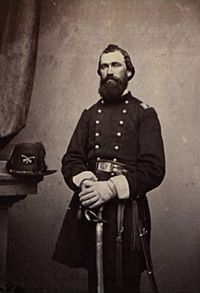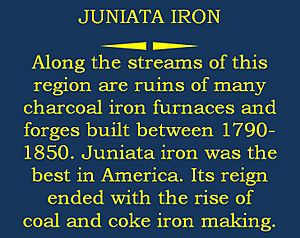Jacob C. Higgins facts for kids
Quick facts for kids
Jacob C. Higgins
|
|
|---|---|

Colonel Jacob C. Higgins
|
|
| Birth name | Jacob C. Higgins |
| Born | March 7, 1826 Williamsburg, Pennsylvania |
| Died | June 1, 1893 (aged 67) Johnstown, Pennsylvania |
| Buried |
Grandview Cemetery
Johnstown, Pennsylvania |
| Allegiance | United States of America |
| Years of service | 1847–65 |
| Rank | Colonel |
| Commands held |
|
| Battles/wars | |
Jacob C. Higgins (1826–1893) was an important military leader from Pennsylvania. He fought in two big wars: the Mexican–American War and the American Civil War. During the Civil War, he led the 125th Pennsylvania Infantry regiment in very tough battles. This included the Battle of Antietam, known as the 'Bloodiest Day in American History,' and the Battle of Chancellorsville, another very bloody day. After his regiment finished its service, Colonel Higgins helped organize special militia troops. These troops protected important railroad and iron factories in Pennsylvania during the Gettysburg Campaign.
Contents
Early Life
Jacob Higgins was born in 1826 in Williamsburg, Pennsylvania. This area later became part of Blair County. He grew up in a rugged, mountainous part of the state. Because of his family's strong background, Higgins learned to be tough and independent from a young age.
Fighting in the Mexican–American War
When the Mexican–American War began, Jacob Higgins joined "The Wayne Guards." This was Company M of the 2nd Pennsylvania Infantry in 1847. His regiment gathered in Pittsburgh and then sailed to Mexico. They joined General Winfield Scott's army.
By September 1847, General Scott's army was close to Mexico City. But first, they had to attack a strong fort called Castle Chapultepec. Higgins was hurt during this attack. However, the very next day, he was part of the group that captured Mexico City. His regiment finished its service on July 21, 1848.
Civil War Commands
First Pennsylvania Militia
When the Civil War started in 1861, Jacob Higgins was working at Portage Iron Works in Duncansville, Pennsylvania. He quickly answered Governor Curtin's call for troops. The governor asked him to come to Harrisburg right away. At that time, Higgins was a Colonel in the Pennsylvania Militia. On April 20, 1861, he became a Captain and Quartermaster in the Second Brigade.
First Pennsylvania Cavalry
In July 1861, Higgins left his previous service. He then helped create Company G, First Pennsylvania Cavalry. He became a Captain on August 1, 1861. On September 27, he was promoted to Lieutenant Colonel of the First Pennsylvania Cavalry. He commanded five companies. At the Battle of Dranesville on December 20, 1861, he led these five companies into the fight.
His cavalry was ordered to move forward and find the enemy's position. Colonel Higgins sent two companies to the north of the town. Three other companies charged directly through the town. They kept going until the enemy attacked them from the side and behind. This forced them to pull back. After this, the main infantry troops started fighting. Higgins's cavalry then supported a cannon battery until the battle ended. The Union forces won, and the enemy was completely defeated. The First Pennsylvania Cavalry is also known as the 44th Pennsylvania Volunteers.
125th Pennsylvania Infantry

In 1862, Higgins left his command. He then helped recruit the 125th Regiment, Pennsylvania Volunteer Infantry. He became its Colonel on August 16, 1862. He was with the regiment at South Mountain but did not fight there. He was at the Battle of Antietam on September 17, where his regiment suffered many losses. He also traveled with the regiment to Fredericksburg.
Higgins was at the Battle of Chancellorsville in Virginia. In this five-day battle, he commanded the left side of the Second Brigade. When General T. L. Kane was temporarily unable to fight, Higgins took command of the entire Second Brigade. His regiment's service ended, and he was mustered out (released from duty) in Harrisburg on May 18, 1863.
Emergency Militia of 1863
During the Confederate invasion of Pennsylvania, the Union Army's main goal was to chase and defeat General Lee. But they also had to stay between Lee and important cities like Washington and Baltimore. This meant that the defense of Pennsylvania was left to others. Volunteer militia groups were formed to protect key areas.
Confederate General John D. Imboden's "Northwestern Brigade" had about 2,100 men and six cannons. In June 1863, his group destroyed bridges, train cars, depots, and water tanks belonging to the Baltimore and Ohio Railroad. They also cut the Chesapeake and Ohio Canal in Maryland. After entering Pennsylvania, they quickly got horses from local areas, making them a fully mounted cavalry unit. Imboden's Brigade was meant to scout ahead and gather supplies for General Robert E. Lee's army.
Major General Darius N. Couch asked Colonel Higgins to raise a regiment. Governor Andrew Curtin then put Higgins in charge of the militia in south-central Pennsylvania on June 16. Higgins's men quickly built temporary forts in mountain passes. He also worked with parts of General Robert H. Milroy's defeated troops, who had retreated to Bloody Run. Higgins gave Milroy's men cannons and loaned them a battalion of soldiers for a trip toward McConnellsburg.
At McConnellsburg on June 29, Imboden's Brigade faced its first defeat. A company of Confederate cavalry was ambushed by Union cavalry and unarmed militia. The Confederates fled and were defeated in a sword fight. Two Confederate soldiers were killed (the first to die in battle on Pennsylvania soil). Their captain, a lieutenant, and about twenty other men were captured.
After the war, General Lee's orders to Imboden were revealed. Lee told Imboden to go into Pennsylvania as far as he thought was safe, west of North Mountain. He was also told to watch Milroy's troops. This meant Imboden had the authority to move against important places like Altoona if he thought it was a good idea.
22nd Pennsylvania Cavalry
Colonel Higgins then helped recruit a group of five cavalry companies. These companies became part of the Twenty-second Regiment, Pennsylvania Volunteer Cavalry. As the Colonel of this regiment, he fought in the Shenandoah Valley and the mountains of West Virginia. He often commanded the entire Brigade. He also commanded General Stahl's Division for some time.
After a surprise attack captured the post at New Creek, General Sheridan ordered Higgins to go there immediately. He was to take command and get the post ready for fighting. His command was the Second Brigade, Second Division, Department of West Virginia. He had three artillery batteries, one fort, and 3,000 to 4,000 troops. His area covered from Hancock, Maryland, to Piedmont, West Virginia, with his headquarters at New Creek. He stayed there until the war ended and was released from duty on July 21, 1865.
Cavalry Brigades
At the Second Battle of Kernstown on July 24, 1864, Higgins commanded the Second Brigade of the 1st Division Cavalry.
After the War
Jacob C. Higgins was a member of two veteran groups: U.V.L. No. 60 and Emery Fisher Post No. 30, G.A.R., in Johnstown, Pennsylvania. He remained a member until he passed away on June 1, 1893. He was buried in the cemetery in Johnstown, Pennsylvania.



